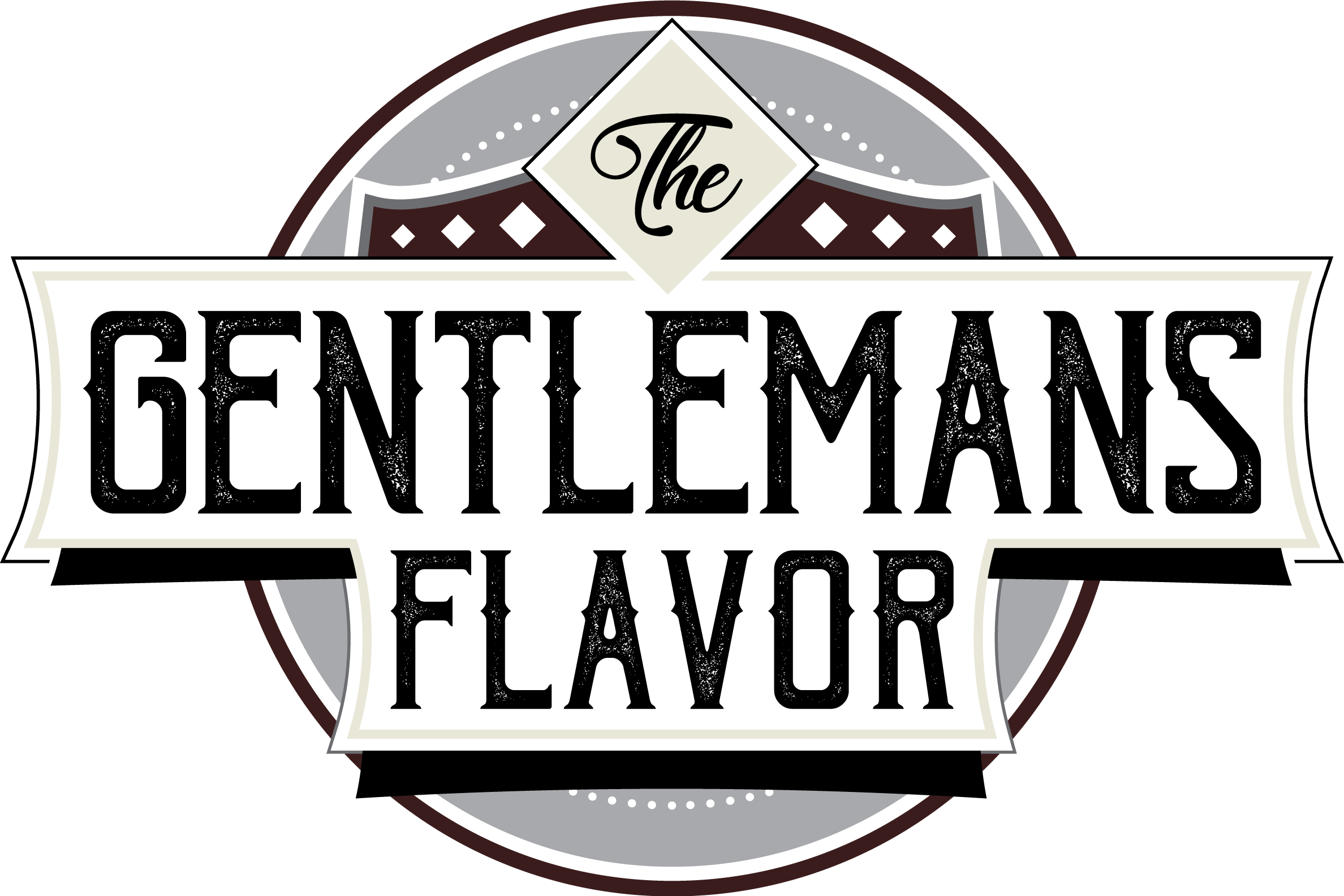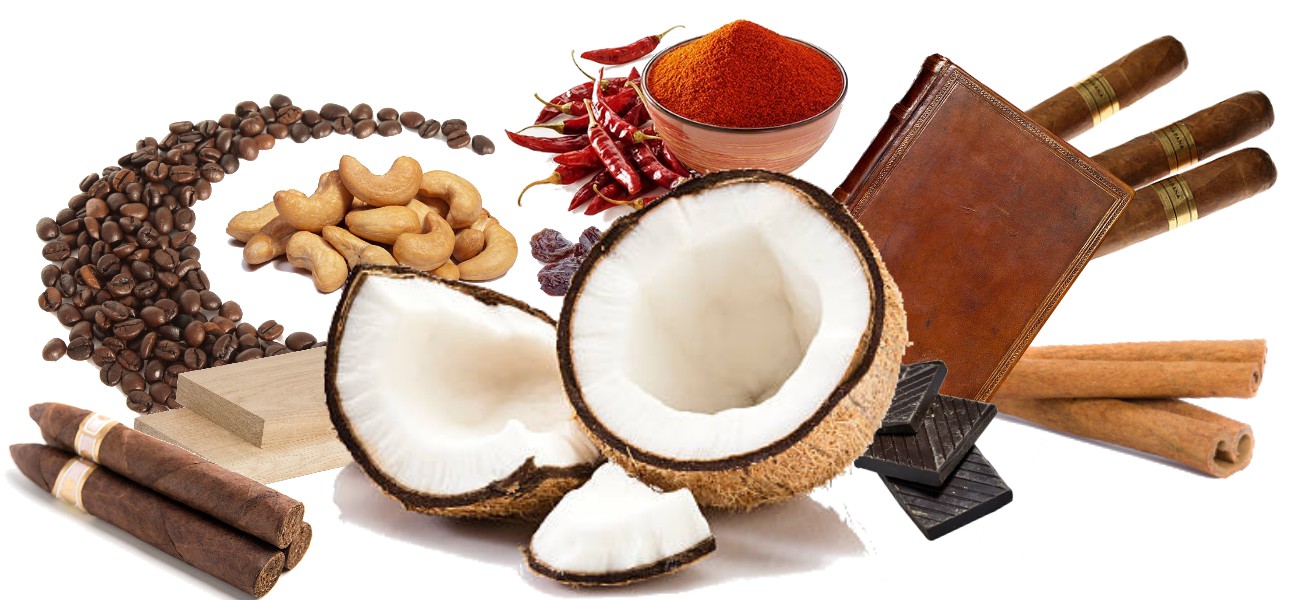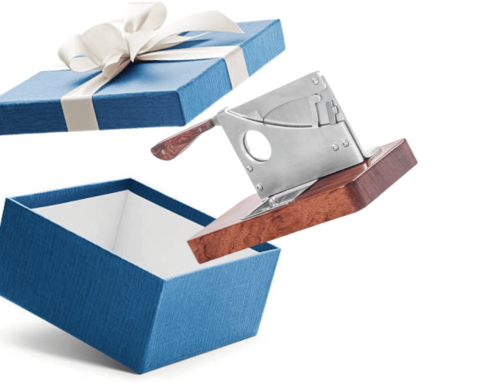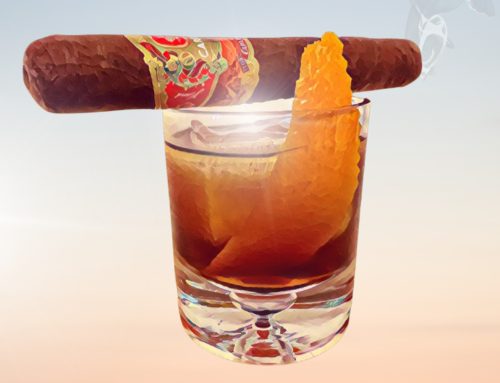Have you ever scratched your head after reading a cigar review and thought to yourself, “how the heck did they experience all those different flavors? All I taste is smoke!”

If so, you’re not alone in this thinking, and it certainly doesn’t mean that you don’t appreciate cigars just as much as some lucky cigar reviewer does.
The truth is that they started out simply tasting (and smelling) ‘just smoke’ too. Until over time, those distinct flavors and nuances (like marzipan, baking spices, dark chocolate or hickory for example) started popping into their brain whilst smoking their cigar.
Thankfully, with the right combination of practice (aka, smoking more cigars), reading more cigar reviews and doing some sensory work with things like an aromatics flavor notes kit, you can soon train your brain to pinpoint different flavors and aromas from your cigar. This can trigger a memory of certain things you’ve previously tasted or had a good solid whiff of at some point in your life.
Cigars and The Senses
When it comes to things like cigars (or even spirits), there are two primary senses that go to work, called the Gustatory and Olfactory – or in cigar smoker layman’s terms, your sense of taste and smell.
When discussing the sensory evaluation of a cigar, it must be first emphasized that when it comes to your nose or your palate, there is no wrong answer.
Though there are often many commonalities that cigar enthusiasts will agree upon in a particular cigar, no one has the same palate or nose as you do. Your palate and nose have been shaped by all the different things you have tasted and smelled throughout your lifetime thus far.
For example, certain reviewers in the UK or with British lineage will detect things like Christmas cake or treacle in the notes of a cigar. Christmas cake is a very British tradition that began as plum porridge, and treacle is a particular uncrystallized syrup that can be found within many a British pantry.
To my knowledge, I have never had Christmas cake nor treacle, and therefore wouldn’t identify them when smoking a cigar.
My point is this: there are no universal commonalities in the sensory evaluation of a cigar, only ones that trigger a memory within the life experience of the cigar smoker.
It is a completely subjective experience.
The main point of cigar sensory evaluation is to shift the unconscious associations that are hidden in the recesses of your brain to becoming conscious ones. This way, you can easily isolate and identify particular elements while enjoying a cigar.
Gustatory Sense: Taste
Let’s discuss the senses in more detail.
Before lighting your cigar, cut it and take in a cold draw to experience some flavor from the wrapper and the leaves in their cured state.
Take it from world-renown cigar maker Manuel “Manolo” Quesada, who says “Dry smoking a cigar is a good idea. If you draw dry, you will get all of the nuances that will come to the palate after lighting the cigar. It’s also good to compare how the dry smoke was in comparison to the lit smoke.”
Dry smoking or taking in a “cold draw” is also useful to ensure that your cigar is not plugged with too-tightly packed or knotted tobacco.
When smoking a cigar, molecules from both the cigar itself and the smoke it releases connect with our saliva and trigger an unconscious association with something we’ve tasted before within our tastebuds.
When it comes to our tastebuds, we have the ability to detect 5 basic tastes: sweet, sour, bitter, salty and savory (also known as umami). Of the 5, sour and to a much lesser extent, bitter are usually ones that cigar makers don’t aim for when creating a cigar. Sweet, salty and savory are more commonly perceived as pleasant, and are often omnipresent in the taste of cigars.
When smoking a cigar, in addition to using the basic 5 tastes, we also can add certain tactile mouthfeel elements such as creamy, oily, spicy and dry to further describe our cigar’s taste.
This verbiage gives us a lot to work with right off the bat – long before skillfully identifying cardamom as a distinct flavor note within your cigar.
This is not only useful at identifying commonly welcomed flavor notes (such as maybe dark chocolate, almonds or vanilla), but also at detecting certain undesirable notes as well (like tar, sulphur, plastic, or rubber for example).
However though truth be told, what one cigar enthusiast deems undesirable, another may consider pleasurable.
Pencil shavings anyone?

Try sipping sparkling water in between puffing on your cigar. Mineral water will work to revitalize and refresh your palate, leaving it better equipped to detect the nuances and aromas of your cigar.
When discussing the sensory evaluation of a cigar, it must be first emphasized that when it comes to your nose or your palate, there is no wrong answer.”
Olfactory Sense: Smell
It’s often said that your olfactory sense of smell – located by the receptors in your nose – is the strongest when it comes to triggering a memory. Many (but not all) of the notes experienced by the gustatory senses will also be experienced by the olfactory ones when it comes to a cigar.
Before lighting your cigar, take in its smell in an unlit state.
When we speak of the aromas produced by a lit cigar, we speak of not only the smell of the smoke in the air, but also the smell of the smoke in your sinus cavities.
This can be heightened by an act called ‘retrohaling’. Retrohaling refers to the act of blowing smoke out through your nose.
To retrohale, you draw the smoke in from the cigar to your mouth, close your mouth and then close off the back of your throat (so as not to inhale). You then push your tongue up to the roof of your mouth before finally releasing the smoke out through your nose.
Retrohaling takes practice and is not for everyone, but can be a useful tool to unlock deeper layers of nuances from within your cigar.
As an added tip, try closing your eyes as you take in your cigar’s smoke. Visual elements in your field of view can distract your brain from concentrating on the taste and aroma nuances within your cigar.
Also make certain that there are no other competing aromas (like cooking food, candles, air freshener, or cleaning solvents for example) in the vicinity of where you are enjoying your cigar.
Sensory Homework: Practice Makes Perfect
Like all things, identifying the flavor notes and nuances of a cigar takes practice and time.
Smoking cigars and reading cigar reviews will help you develop a sort of ‘flavor Rolodex’ within your head of many of the common flavor elements that are perceived from a cigar. By reading reviews, you will begin to stockpile a growing list of common flavor characteristics and then begin to easily recall them when accessing a cigar.
What I’ve also found extremely useful is taking the time to smell what the world has to offer, such as flowers, food, liquids, spices, wood-constructed items, leather-constructed items, and many other natural, as well as man-made elements.
Ask yourself; how can you identify something you’ve never come across before?
Imagine that were out in the wild and an ocelot ran in front of you. If you’ve never seen an ocelot before – in a book, on tv or at the zoo perhaps, how would you identify it as an such?
You likely couldn’t.
However, if you made it a point to research animals that are often seen in the areas that you intend to hike, having read about one and seen its image beforehand would exponentially increase your likelihood of recognizing it upon spotting one.
I think you get my point.
Using allspice while cooking, adding cinnamon to your hot apple cider or smelling a freshly opened package of baking chocolate are all examples of putting yourself in sensory contact with the many commonly occurring flavor elements within a cigar.
Using An Aromatics Kit
An incredibly valuable tool that I’ve incorporated to up my game when it comes to reviewing cigars (as well as spirits, wine and beer) and identifying their nuances is an Aromatics Flavour Notes Kit.

Bevs Burns Flavour Notes Kit
Created by Bevs & Burns in Canada to “truly taste your Bevs & Burns”, the Aromatics Flavour Notes Kit was meticulously created to compile and organize many of the common flavor notes found within their line of cigars.
Though of course I could have gone out to locate many of these elements myself, it’s extremely convenient to have them simply pre-organized and assembled inside an easily locatable kit that I can use and reuse to remind myself of the many common aroma threads found within a cigar.
Items such as roasted coffee, dried apricot, cocoa nibs, rawhide leather, graham cracker, white pepper, liquorice and many more are contained within the kit to reference and assist in my growing ability to quickly isolate and identify certain notes on the nose and the palate.
Also, as there are many overlapping notes that are found in things like whiskey, rum, and cognac, the Aromatics Flavor Notes Kit has greatly assisted in my sensory analysis of a wide array of spirits as well.
Conclusion
Whether you’re a wet-behind-the-ears cigar noob, an intermediate, or grizzled seasoned veteran to cigars, we all are constantly learning and refining our nose and palate.
The best advice I can give is to have patience, grasshopper.
Enjoy plenty of different cigars. Read cigar reviews. Get yourself a cigar Aromatics Flavor Notes Kit. And most importantly – stop and smell the roses so to speak.
Before you know it, you’ll be loving all those cashew, salt, cedar, raisin and dark roast coffee notes that you’re identifying in your latest, wonderful cigar.
– Kurt Bradley

Kurt Bradley is the founder of The Gentleman’s Flavor, to which he is also a contributing editor, host and curator.
Born in Toronto, Canada, Kurt has lived in Glasgow, Scotland where he developed a passion for understanding whisky. Kurt is a certified Whisky Ambassador accredited by The Scotch Whisky Association and has achieved Level 2 Award in Wine & Spirits Education Trust with distinction. He is a regular contributor to Cigar Journal Magazine, and has provided commentary to Cigar Aficionado, the world’s leading cigar publication.
He enjoys a fine, hand made cigar with a well-crafted Old Fashioned cocktail.












